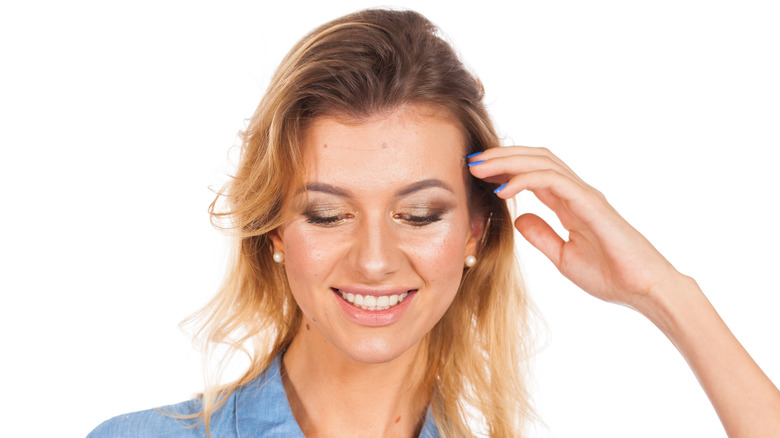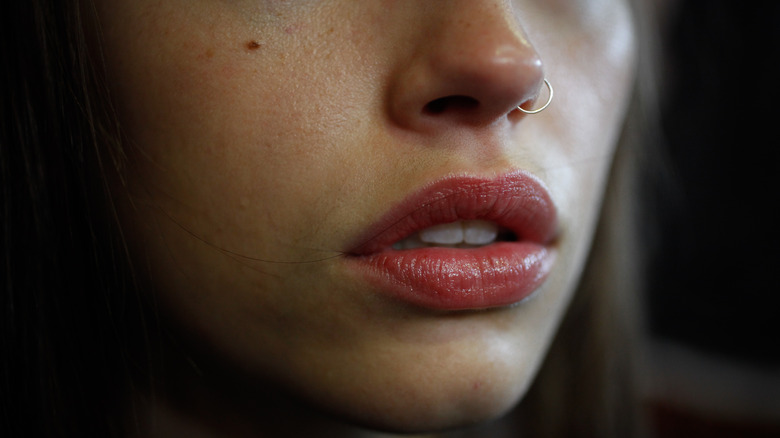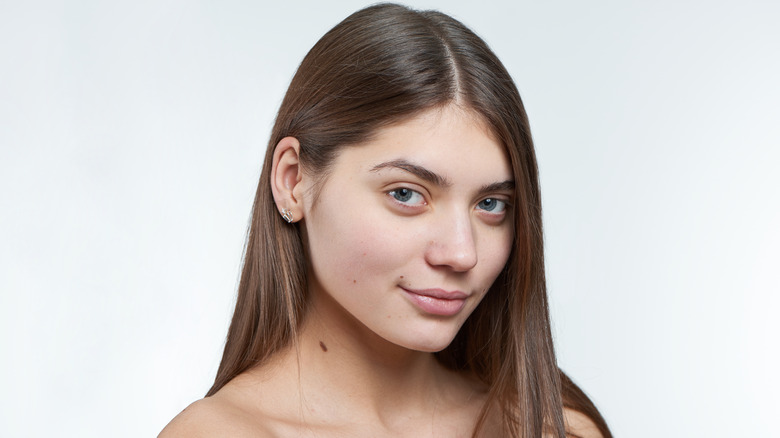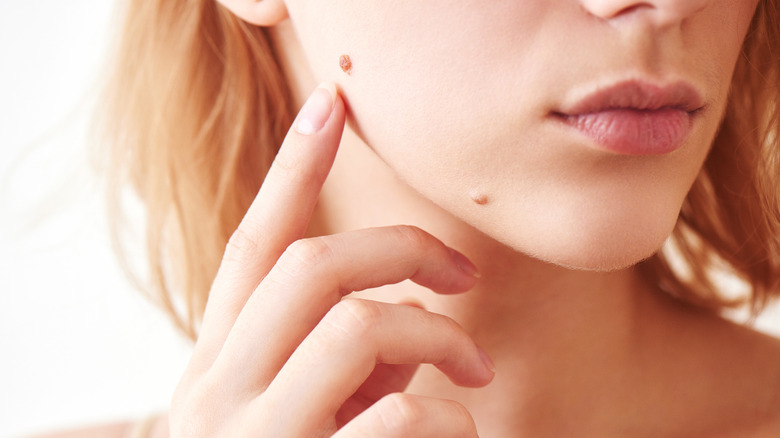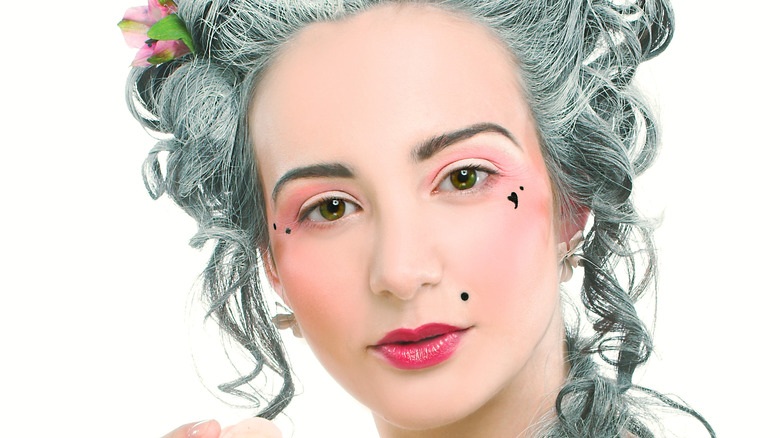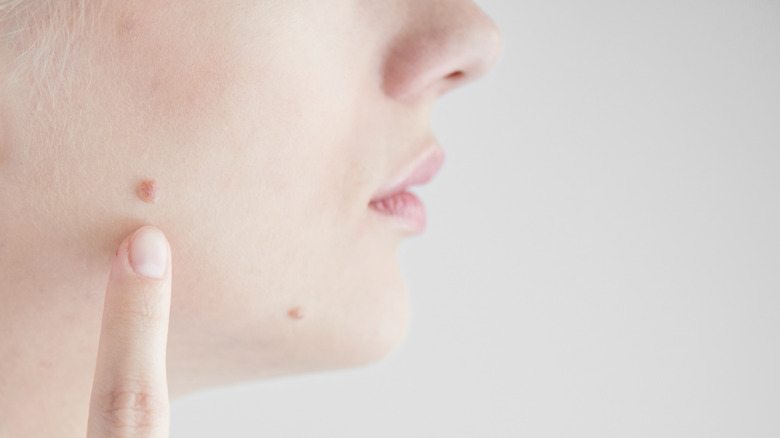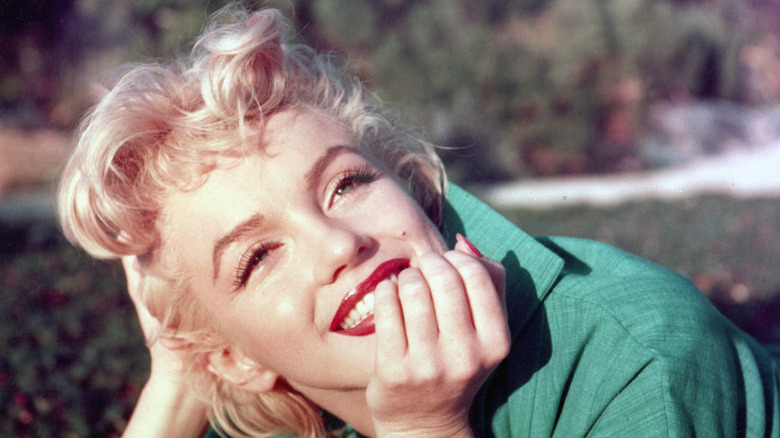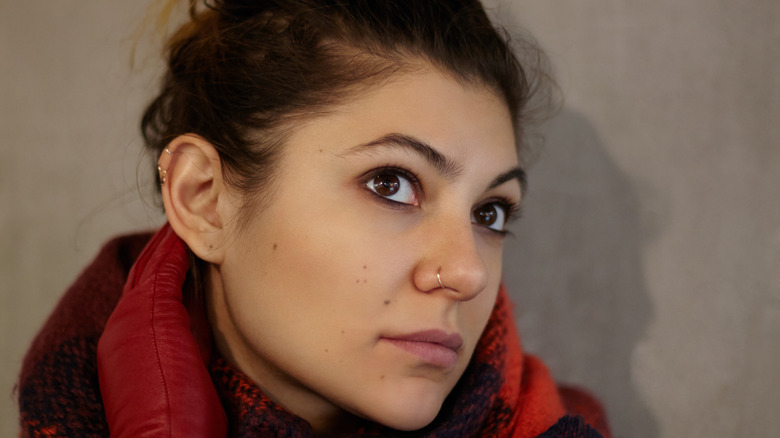The Truth About Beauty Marks
In your lifetime, beauty marks have likely been seen as a sign of, well, beauty. This is partially dictated by Hollywood's elite. Cindy Crawford, for example, is notorious for her iconic "blemish." Yet, even she considered having surgery to get rid of it. "I would get teased by the other kids in school, so I definitely wanted to get it removed," the supermodel told Vogue. These days, Crawford realizes that her well-placed spot helps her remain recognizable and unique. It also helps other women with beauty marks to have an ally with which to identify. Speaking candidly with the magazine, Crawford did admit that she's still not sure if she'd have added a beauty mark if "designing [her] face from scratch." Gasp! It's hard to even imagine Crawford without it.
The American supermodel isn't the only one with an iconic beauty mark. Kate Upton and Blake Lively have certainly helped the spot stay en vogue today. But, just what is a beauty mark anyway? And why do people love them — or hate them? Here's the unadulterated truth.
Not all moles are beauty marks
"All beauty marks are moles," Neal Schultz, a New York City-based cosmetic and medical dermatologist and host of DermTV, explained. As such, the shape, color, and even texture can vary. This naturally raises the question: Why are there two different names?
"Because the term 'beauty marks' has an aesthetic connotation, we generally tend to call moles on the face beauty marks, while the same exact mole elsewhere on the body is just called a mole," Schultz clarified. So, while Cindy Crawford and other big names with facial moles are often credited with having iconic beauty marks, celebs with body moles aren't given quite the same label. Jennifer Lawrence, for instance, has been dubbed the "mole-iest" — not most beauty-marked — sex symbol of all time by Slate because her pigmented spots happened to land not just on her face, but on her neck and chest as well. Who knew the social science behind moles could be so complicated?
Maybe she's born with it, maybe it's ... a beauty mark
If you've ever heard of a beauty mark being labeled a birthmark, that's not exactly fake news. According to the American Academy of Dermatology, there are several kinds of birthmarks, but each one fits into just two main groups: pigmented and vascular.
Pigmented birthmarks simply mean your spots contain more color than other parts of your skin. Moles, Mongolian spots, and cafe-au-lait spots are all considered types of pigmented birthmarks. Vascular birthmarks, on the other hand, are formed when "extra blood vessels ... clump together." Salmon patches (sometimes known as "stork bites"), hemangioma (what some people call "strawberry marks"), and port wine stains, are some common forms of vascular birthmarks.
While vascular birthmarks — like stork bites and strawberry marks — are always something a person is born with, and therefore a real-deal birthmark, pigmented spots — like moles — are a bit more nuanced. You can be born with one, or you can develop one at a later point in your life. Simply put, if a person is born with a mole, it is then also considered a birthmark.
Shakespeare was into them
Whether or not your beauty mark is also a birthmark, romanticist William Shakespeare would've so been into it. Shakespearean expert and literary historian Stephen Greenblatt lectured students at the University of Science and Arts of Oklahoma on "Shakespearean Beauty Marks." While much of the world in Shakespeare's time was focused on "spotless beauty," the poet and playwright found imperfection to be rather stunning. Much of Shakespeare's work features "figures who are, in the perception of age, 'stained,' and yet whose stain is part of their irresistible, disturbing appeal," according to Greenblatt.
Innogen from the play "Cymbeline" proves this to be true as she just so happened to have a facial mole, or, beauty mark. "Her mole is not part of any formal perfection, but it is also not an ornament," Greenblatt explained. "It is a mark of all that Shakespeare found indelibly beautiful in singularity and all that we identify as indelibly singular and beautiful in his work," the historian further added. That's right ladies, moles are beautiful.
They were used to cover up smallpox scars
In the 17th and 18th centuries, smallpox was running rampant in Europe. Several kings and queens even succumbed to the disease and, according to History.com, it is thought that 400,000 commoners died each year as a result. It was an uphill battle even for those who survived. A report published by the Journal of the American Academy of Dermatology (via NCBI) highlighted the "disfiguring scars" left in the disease's wake.
But what better way to hide one of those "disfiguring scars" than with a cleverly placed beauty mark? Racked explained how women first started applying mouse fur — yes, mouse fur — to their pockmarks. British Parliament wasn't a fan of this tomfoolery, though. So much so that, in 1650, they created a bill to prevent "the vice of painting, wearing black patches, and immodest dresses of women."
Even still, the trend took off and transformed into decorative patches or mouches ("flies" in French), in which faux moles made of colorful silk, taffeta, and leather were applied to the face. An entire faux mole industry was born and a street in Venice, Calle de le Moschete, was named in its honor. Long live the mouches!
Beauty marks got political
From the books you read to the clothes you wear, there are plenty of ways to make a political statement. However, there is perhaps no stranger way than to declare your party affiliation via mole. As you now know, the 18th century was the time for magnificent moles. While a real mole's shape is fixed, a mouche could be designed in a variety of styles. According to BBC, stars, hearts, and half moons were all popular choices back in the day. Before long, mouches made their way into politics.
If a woman were to wear the appliquéd beauty mark on the left side of her face, this would mean she supported the Tory political party. Likewise, if she were to wear one on the right side, she would be showing her support for the Whigs. Imagine the awkwardness of having a real beauty mark during this period in history? What a time to have been alive.
"A mark of disgrace"
Even though British Parliament wanted to put an end to the faux mole craze, some members eventually came around. Samuel Pepys, who originally prohibited his wife from wearing one, had a change of heart. Karen Hearn, an honorary professor of English at University College London, told BBC, "He found them worrying." She added, "But he obviously also found them sexy."
Even by the mid-1800s, not everyone had opened their minds like Pepys. In contrast, even natural moles were looked at as "a mark of disgrace," Madeleine Marsh, author of The Compacts and Cosmetics: Beauty from Victorian Times to the Present Day, explained to BBC. Under Queen Victoria's reign, beauty standards left little room for anything but smooth, white skin. As if that weren't cringe-worthy and problematic enough, the use of makeup was reserved for "prostitutes and actresses."
Those with beauty marks in the 1800s would've likely felt anything but beautiful during a time when skin whitening recipes promising to "take away" freckles and moles were abundant.
The beauty mark revival
The perception of beauty marks has come a long way since the 1800s, though, that's not to say it happened overnight. Madeleine Marsh told BBC that it wasn't until Hollywood came to be that moles transformed from something to be abhorred to something to be admired. "Hollywood revolutionised women's faces," Marsh explained, "Suddenly you were seeing these HUGE women's faces, bigger than we had ever seen them before." One of those famous faces was Marilyn Monroe. While Biography stated that no one truly knows if Monroe's beauty mark was real, drawn on, or accentuated with makeup, one thing is for sure: she helped propel the look into mainstream.
Still, our work isn't quite done yet. Farid Haddad, managing director of BMA Models, told BBC, "Men and women are both expected to be 'flawless' in the fashion world. Any moles or flaws are usually Photoshopped out to create the image of beauty." He hopes one day "moles and other individual qualities" will be embraced. Hear, hear!
Faux beauty marks are still a thing
PETA would be none too pleased if women were still applying mouse fur to their faces in an effort to mimic a mole. Though, we doubt they'd be the only ones perplexed by the idea. With smallpox being all but eradicated by the 19th century, the demand for mouches would eventually become nonexistent. That's not to say all faux beauty marks went out of style. As stated earlier, Monroe's trademark mole may not have been real. She wouldn't have been the only one to fake it, though.
"I like moles. I think they're the cutest thing. It's all Marilyn Monroe's fault," singer Kelly Rowland told People. For Rowland, it all began with putting a dot of black Duo lash glue on her face. "It was the cutest stinking mole, and I was sold," she admitted. These days, Rowland doesn't like to leave home without her trusty appliquéd beauty mark. She also doesn't apply the spot in the same place. Instead, she calls it her "forever moving mole" and sometimes draws it on to cover a blemish. She likes what she likes, okay?
When to worry about your real beauty mark
A good thing about fake moles is that there's zero risk of one turning into skin cancer. If you have a real beauty mark, however, you should be aware of what the Skin Cancer Foundation calls the "ABCDE" signs of melanoma, the deadliest form of skin cancer. If you notice your beauty mark starting to look asymmetrical, the border or edges are uneven, it has variations in color, grows in diameter, or evolves over time, you should make an appointment with your dermatologist to get it checked out.
In an interview with Redbook, Ranella Hirsch, a dermatologist and senior medical advisor to Vichy Laboratoires, further warned, "New things on your skin tend to be bad." If you just so happen to wake up one morning and find a brand new beauty mark staring back at you in the mirror, take note. And even if that new mole is fine today, that doesn't mean it will be tomorrow. Possibly up to half of all melanomas start as benign moles. Beauty marks may very well always be beautiful, but the truth behind them is often less glamorous.

